chapter 3 翻译策略
- 格式:ppt
- 大小:2.72 MB
- 文档页数:57
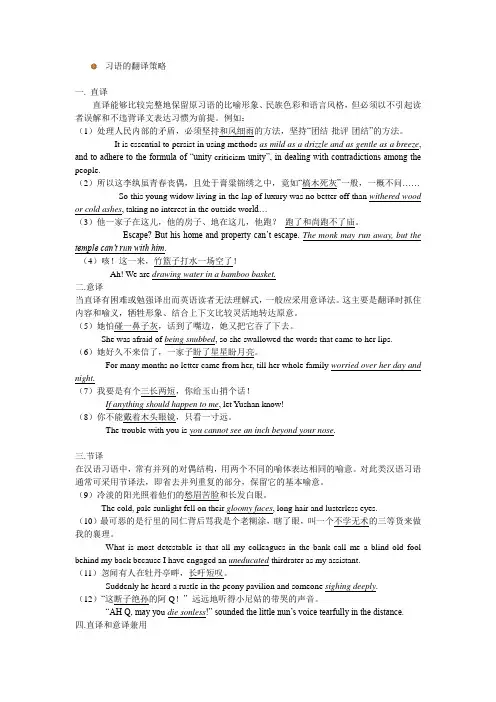

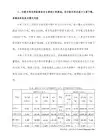
第一节文化背景BrainstormingTranslate the following into Chinese1.I haven’t seen you for donkey’s year.我很久没有见到你了。
2.Birds of a feather flock together.物以类聚,人以群分。
3.Seeing is believing.耳听为虚,眼见为实。
4.I wonder if he is a Trojan horse.我不知道他是不是个危险人物。
5.It’s case of January and May.这是老牛吃嫩草。
/ 他们是老夫娶少妻。
Part V Practical trainingTranslate the following English sentences into Chinese1. China benefits a lot from her past 20 year’s open door policy.中国从过去20年的门户开放政策中得到了许多实惠。
2. The return of Hong Kong to China turned over a new leaf in China’s history.香港回归在中国发展史上翻开了崭新的一页。
3. Jack was warned that his job was on the line because of his lack of concentration for his duties.杰克因为干活精力不集中而受到警告,他的工作处在危险的边缘。
4. The president said, “Great minds think alike. So I totally agree with your idea.”主席说:“真是英雄所见略同啊。
我完全同意你的观点。
”5. The news that the firm was closing down came as a bolt from the blue to the staff. 商行要倒闭的消息对该行职员来说犹如晴天霹雳。
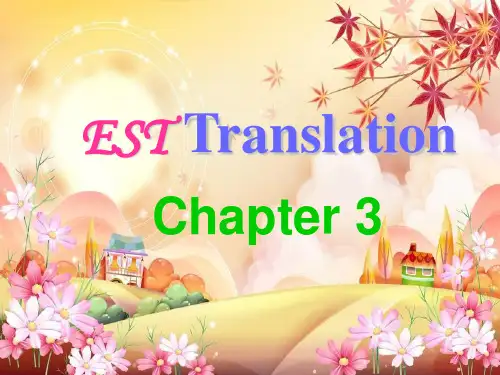
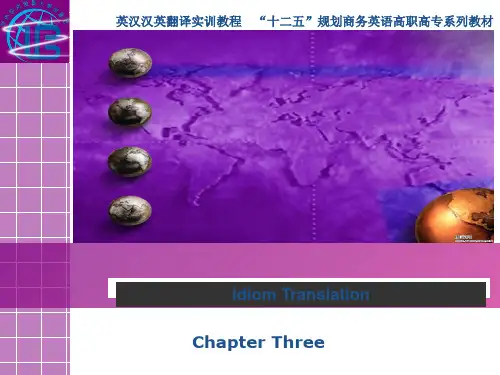
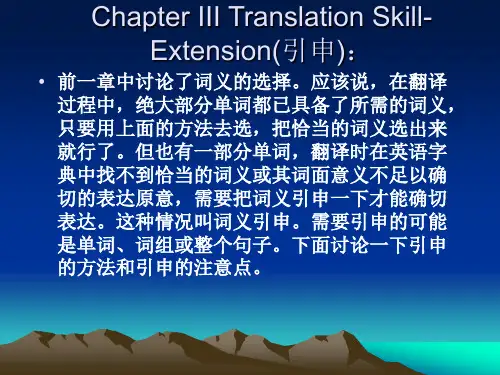
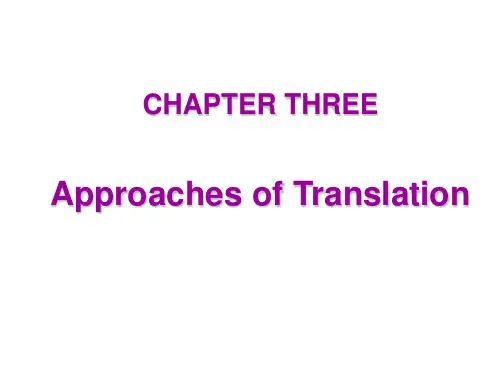
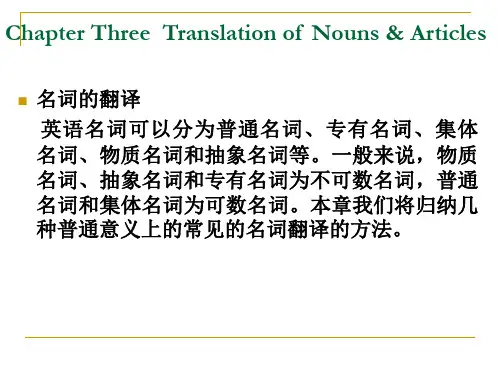
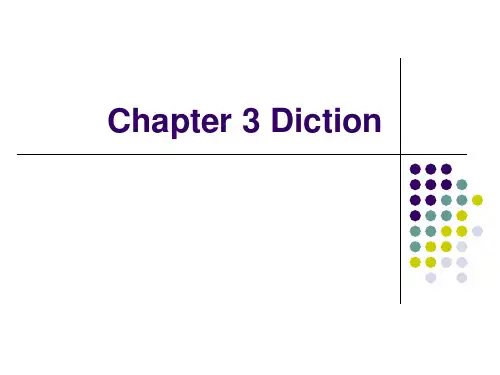
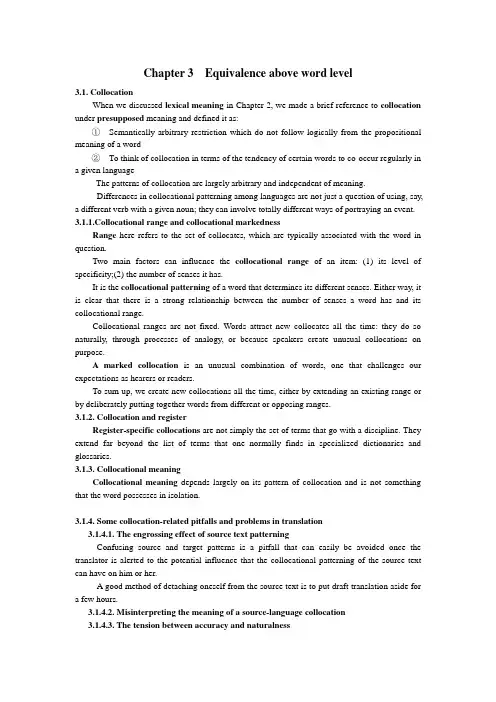
Chapter 3 Equivalence above word level3.1. CollocationWhen we discussed lexical meaning in Chapter 2, we made a brief reference to collocation under presupposed meaning and defined it as:①Semantically arbitrary restriction which do not follow logically from the propositional meaning of a word②To think of collocation in terms of the tendency of certain words to co-occur regularly ina given languageThe patterns of collocation are largely arbitrary and independent of meaning.Differences in collocational patterning among languages are not just a question of using, say,a different verb with a given noun; they can involve totally different ways of portraying an event.3.1.1.Collocational range and collocational markednessRange here refers to the set of collocates, which are typically associated with the word in question.Two main factors can influence the collocational range of an item: (1) its level of specificity;(2) the number of senses it has.It is the collocational patterning of a word that determines its different senses. Either way, it is clear that there is a strong relationship between the number of senses a word has and its collocational range.Collocational ranges are not fixed. Words attract new collocates all the time: they do so naturally, through processes of analogy, or because speakers create unusual collocations on purpose.A marked collocation is an unusual combination of words, one that challenges our expectations as hearers or readers.To sum up, we create new collocations all the time, either by extending an existing range or by deliberately putting together words from different or opposing ranges.3.1.2. Collocation and registerRegister-specific collocations are not simply the set of terms that go with a discipline. They extend far beyond the list of terms that one normally finds in specialized dictionaries and glossaries.3.1.3. Collocational meaningCollocational meaning depends largely on its pattern of collocation and is not something that the word possesses in isolation.3.1.4. Some collocation-related pitfalls and problems in translation3.1.4.1. The engrossing effect of source text patterningConfusing source and target patterns is a pitfall that can easily be avoided once the translator is alerted to the potential influence that the collocational patterning of the source text can have on him or her.A good method of detaching oneself from the source text is to put draft translation aside fora few hours.3.1.4.2. Misinterpreting the meaning of a source-language collocation3.1.4.3. The tension between accuracy and naturalness3.1.4.4. Culture-specific collocations3.1.4.5. Marked collocation in the source text3.2. Idioms and fixed expressions3.2.1. Idioms, fixed expressions and the direction of translation"N ative knowledge" is defined as the ability to speak and write a language so fluently that the expression of thought is structurally, grammatically and idiomatically correct.The main problem that idiomatic and fixed expressions pose in translation relates to two main areas:①The ability to recognize and interpret an idiom correctly②The difficulties involved in rendering the various aspects of meaning that an idiom or a fixed expression conveys into the target language.3.2.2. The interpretation of idioms①Some idioms are misleading; they seem transparent because they offer a reasonable literal interpretation and their idiomatic meanings are not necessarily signalled in the surrounding text.②An idiom in the source language may have a very close counterpart in the target language which looks similar on the surface but has a totally or partially different meaning.3.2.3. The translation of idioms: difficultiesAn idiom or a fixed expression may have no equivalent in the target language:①Express a given meaning by means of a single word②Express it by means of a transparent fixed expression③Express it by means of an idiomAn idiom or fixed expression may have a similar counterpart in the target language, but its context of use may be different; the two expressions may have different connotations or they may not be pragmatically transferable.An idiom may be used in the source text in both its literal and idiomatic senses at the same time. The very convention of using idioms in written discourse, the contexts in which they can be used, and their frequency of use may be different in the source and target languages.3.2.4. The translation of idioms: strategies3.2.4.1. Using an idiom of similar meaning and formIt is to use an idiom in the target language which conveys roughly the same meaning as that of the source-language idiom and, in addition, consists of equivalent lexical items.3.2.4.2. Using an idiom of similar meaning but dissimilar form3.2.4.3. T ranslation by paraphrase3.2.4.4. T ranslation by omission。
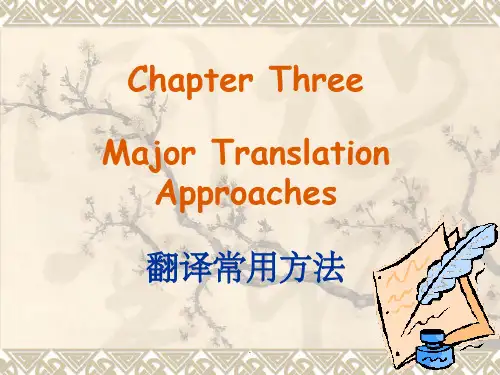
Chapter 3 翻译的过程翻译的过程是正确理解原文和创造性地用另一种语言再现原文的过程,大体上可分为理解、表达和校核三个阶段。
在翻译实践中,理解是表达的前提,但理解与表达通常是互相联系、往返反复的统一过程,不能截然分开。
在理解的时候,译者已自觉或不自觉地在挑选表达手段;在表达的时候,又进一步加深了理解。
在处理句子、段落或文章时,译者往往要从英语到汉语,从汉语到英语,反复推敲,仔细研究。
1 理解阶段——基础和关键理解(comprehension)可分为广义理解和狭义理解。
广义理解指对原文作者的个人、原文产生的时代背景、作品的内容以及原文读者对该作品的反映。
狭义的理解仅指对原作文本的理解。
对原文透彻的理解是确切翻译的第一步,也是翻译全过程最重要的一步。
正确的理解有助于正确的表达,而正确的理解取决于译者能否对原文进行深入细致的语法分析grammatical analysis、语义分析semantic analysis、语体分析stylistic analysis和语篇分析text analysis。
1.1语法分析——从语法的角度去剖析原文里句子的语法结构,弄清句子所传递的意义。
1.She recalled faintly an ecstasy of pain, the heavy odor of chloroform, a stupor which had deadened sensation, and an awakening to find a little new life to which she had given being, added to the great unnumbered multitude of souls that come and go.(重复译法)她模糊地回想起当时极度的痛苦,想起了浓烈的三氯甲烷麻醉剂的气味;她记得自己失去了知觉,昏了过去,而醒来时发现自己又为来来往往的芸芸众生增添了一条小小的新生命。